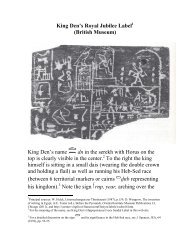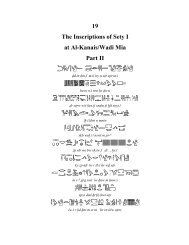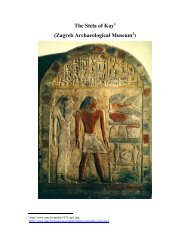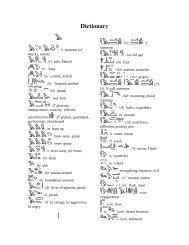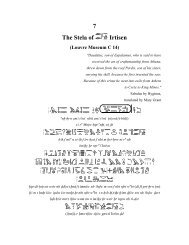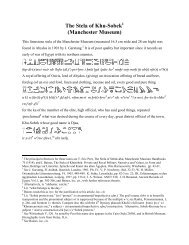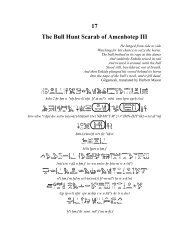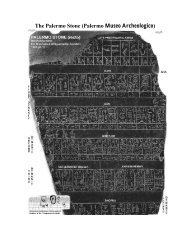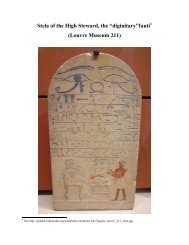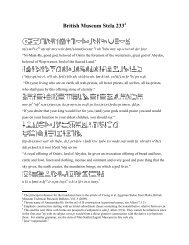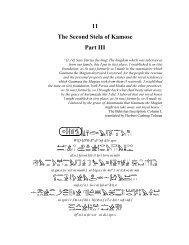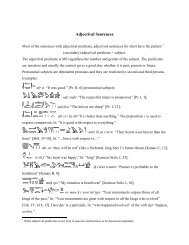Preface - Middle Egyptian Grammar
Preface - Middle Egyptian Grammar
Preface - Middle Egyptian Grammar
Create successful ePaper yourself
Turn your PDF publications into a flip-book with our unique Google optimized e-Paper software.
<strong>Middle</strong> <strong>Egyptian</strong><br />
<strong>Grammar</strong><br />
through<br />
Literature<br />
Gabor Toth<br />
Rutgers University-Camden
<strong>Preface</strong><br />
One day, a group of people in a small Chinese village went to the police station. They<br />
made a formal request to change their family name. The officials were taken aback,<br />
because in China, family names go back generations and families are usually keen on<br />
preserving them.<br />
First, the police thought the reason was that someone in the family was a criminal. Then,<br />
the family revealed that their name was 苟 1 (Gŏu 2 ). This word means “careless,<br />
negligent,” and the written character does not have a negative connotation. But another<br />
word 狗 (gŏu) “dog” is pronounced exactly the same way, and it just happens to be one<br />
of the curse words in Chinese. For example, 狗腿子 (gŏu tuĭ zi) is a rich person’s<br />
enforcer, a henchman, and a typical curse for a bad man is 这个狗东西 (zhè ge gŏu<br />
dōngxi). This is a bit strange since many Chinese family names are animal names. For<br />
example, 马 (mă) “horse” and 牛 (niú) “ox” are frequently occurring Chinese family<br />
names, and the “dog” also has an equal rank with them in the Chinese lunar calendar. But<br />
the children of the 苟 families were always called names in school and were haunted by it<br />
through life.<br />
They also told the police that an old man of the 苟 family remembered that the family’s<br />
original name was not 苟, but 敬 (Jìng). The two names have the character 苟 in<br />
common and differ only by the “side radical” 文.<br />
The police asked for evidence. The family found a local historian and after some<br />
research, he found out that there lived an emperor between 907 and 960 A.D., whose<br />
name was 石敬瑭 (Shí Jìngtáng). The middle character 敬 was the same as the old family<br />
name. The reason for the name change was that in China, one cannot bear the same name<br />
as the emperor. When the Emperor came to power, he decreed that everyone who has the<br />
敬 name must change it. The two characters, 敬 and 苟 are very similar, and so the 敬<br />
families changed their name to 苟. This seemed an innocent choice as a thousand years<br />
ago, “dog” was 犬 (quăn), and 苟 did not have a negative connotation.<br />
Due to evidence the family produced, the police allowed it to change its name. When this<br />
was reported in a newspaper, the police all over China got requests from 苟 families who<br />
now wanted to change their name.<br />
There was a 15-year old girl named 苟 who said she was so inspired by her name change<br />
that she said she was going to become a doctor. But when she did become a doctor, all<br />
the patients knew her real name was 苟 and she became known as the 狗医生 (gŏu<br />
yīshēng) “dog doctor.”<br />
What did we learn form this story? A few Chinese customs may immediately call the<br />
reader’s attention. For example, in ancient China an ordinary citizen could not bear the<br />
1 Unless stated otherwise we use simplified (mainland) Chinese characters.<br />
2 The pinyin Romanization system is used.
same name as the emperor (which is the source of all the problems in the story). This<br />
custom, more like an imperial decree, is alien to ancient Egypt, where officials of the<br />
court and scribes could be called imny “Ameny” during the reign of any of the<br />
pharaohs having their son of Re name imn-m-HAt “Amenemhat.” But<br />
customs aside, comparing the identically sounded characters 狗 and 苟 one can see that<br />
they are composed of a common part and an additional sign. The common part is called<br />
the “phonetic” and the extra sign is the “radical.” The phonetic tells how the sign is<br />
pronounced and the radical usually (but not always) points to or gives a clue for the<br />
meaning of the word. For example, at the left side of the sign 狗 is the so-called “animal<br />
radical” and it appears as part of a whole host of animal names, such as 猪 (zhū) “pig,”<br />
猫 (māo) “cat,” or with related meaning 狠 (hěn) “ferocious, ruthless.” Other radicals are<br />
not so pointed, for example, the connection of the “grass radical” on the top of the sign<br />
苟 with the actual meaning of the word has been obscured by time. These so-called<br />
“picto-phonetic” characters comprise about 80% of the approximately 49,000 Chinese<br />
characters. (They came to China with the Song Dynasty c. 1500-1066 BC.) The radicals<br />
help to distinguish in writing between characters that sound the same. For example, the<br />
sign 古 (gǔ) “ancient” is part of the words 估 (gū) “estimate (person radical),” 姑(gū)<br />
“aunt (female radical),” 菇(gū) “mushroom (grass and female radicals),” 牯 (gǔ) “bull<br />
(ox radical),” 故 (gù) “reason, cause (tap radical),” and 固 (gù) “firm, solid (enclosure<br />
radical).”<br />
The ancient <strong>Egyptian</strong>s were confronted with the same problem: How to distinguish the<br />
roughly 17,000 <strong>Egyptian</strong> short words in writing from each other? Instead of inventing the<br />
Chinese radicals, they came up with a different solution: the system of determinatives.<br />
These extra signs (placed usually at the end of the words) came into existence for the<br />
same reason as the Chinese radicals. Insisting on short words and limiting the total<br />
number of signs inevitably lead to a multitude of coincidences. Although graphically<br />
different, the determinatives serve the same purpose; to distinguish between words that<br />
are spelled the same way. For example, “exist” is part of the words<br />
“open,” “hurry,” “fault, blame,” “stripped off.” They are<br />
transliterated the same way (the verbs in appropriate verb forms) wn, but their meanings<br />
are different.<br />
We also learned from the story that adding a radical to a Chinese character can also<br />
change its sound, for example, adding the “tap radical” to 苟 gŏu, it becomes 敬 jìng.<br />
The radicals can also be combined with each other, for example, the person radical 人<br />
forced into the enclosure radical 口 gives 囚 qiú “captive, prisoner, imprison.” The<br />
ancient <strong>Egyptian</strong>s solved this problem by combining (the passive participle of) the verb<br />
sqr “smite, strike down” with the adjective anx “living, alive” to get<br />
sqr-anx “captive,” lit. “one who is smitten alive.” They also<br />
made sure that the word conveys the correct meaning by inserting many determinatives<br />
wherever possible.
As another example, in the traditional Chinese character 愛 (ài) “love” the middle part<br />
心 (xīn) is the heart radical and the lower part is the hand radical. The composition<br />
carries the simple meaning that a person in love takes his/her heart in hand (and brings it<br />
to the loved one). The similar <strong>Middle</strong> <strong>Egyptian</strong> phrase is composed of a number of signs:<br />
ib.k m a.k 3 “your heart in your hand,” and it carries a different meaning:<br />
“the presence of mind.” 4<br />
In both languages there are many radicals. A Chinese dictionary lists 190-230 radicals<br />
(with the discrepancy due to different interpretations of the combined ones), and<br />
Gardiner’s <strong>Egyptian</strong> <strong>Grammar</strong> has about 108 generic radicals.<br />
Which signs can serve as radicals and which have phonetic values (and which are<br />
ideograms)? Due to the overwhelming ratio of the picto-phonetic characters in Chinese,<br />
this is only a problem in <strong>Middle</strong> <strong>Egyptian</strong>. One of the first difficulties that a student<br />
encounters is that many signs can play both roles. For example every student of <strong>Middle</strong><br />
<strong>Egyptian</strong> learns at the first lesson that the uniliteral the “horned viper” has the<br />
phonetic value f. Only later it turns out that this sign is also the determinative in the word<br />
iti “father.” (What is more, it is actually an ideogram for Upper-Egypt’s XIIth<br />
nome Dw-ft the so-called “mountain of the horned viper.”) In case of the combined<br />
sign (a label from Tomb U-j in Abydos) it is not even clear whether it should be read<br />
as two phonetic signs or as an ideogram combined with a determinative. In the first case,<br />
according to Günther Dreyer, it should be read as Ab-Dw “Abydos,” and in the second, the<br />
elephant stands for Abw “Elephantine” and the determinative designates foreign land.<br />
The Chinese story we just read raised a few basic issues in the Chinese and <strong>Middle</strong><br />
<strong>Egyptian</strong> languages. The past 10 years of teaching an introductory course in <strong>Middle</strong><br />
<strong>Egyptian</strong> at Rutgers University-Camden convinced the author that a profitable and<br />
rewarding way to draw the students’ interests to this subject (and to raise one of the worst<br />
retention rates in languages) is to bring into instruction as many literary works and as<br />
soon as possible. This is especially important in the study of the <strong>Middle</strong> <strong>Egyptian</strong> verbal<br />
structure, the most complex part of the language. For example, faithful translation of the<br />
six sDm.f forms not only requires the understanding of the particular sentence or clause<br />
that they appear in but also the understanding the context they are imbedded in. Reading<br />
literature in any languages however needs at least some rudimentary knowledge of<br />
grammar and vocabulary. This book is no exception. The reader is assumed to have some<br />
familiarity with <strong>Middle</strong> <strong>Egyptian</strong> writing and basic grammar, including the grammar of<br />
forming nonverbal sentences and clauses.<br />
The focus of the book is on <strong>Middle</strong> <strong>Egyptian</strong> verbal structure by studying a variety of<br />
genres of literature. Each lesson text starts with a specific piece of literature and is<br />
followed by its own Vocabulary and <strong>Grammar</strong> Points. For the convenience of the reader,<br />
these vocabularies are assembled into a dictionary at the end of the book.<br />
3 [ShS. 14].<br />
4 Lichtheim’s translation.
The standard references for <strong>Egyptian</strong> <strong>Grammar</strong> used in this manuscript are: A. H.<br />
Gardiner, <strong>Egyptian</strong> <strong>Grammar</strong>, Griffith Institute, 1927, J. E. Hoch, <strong>Middle</strong> <strong>Egyptian</strong><br />
<strong>Grammar</strong>, Society for the Study of <strong>Egyptian</strong> Antiquities Publications, 15, Mississauga:<br />
Benben Publications, 1996, and J. P. Allen, <strong>Middle</strong> <strong>Egyptian</strong>, An Introduction to the<br />
Language and Culture of Hieroglyphs, Cambridge University Press, 2000.<br />
To focus on grammar rather than reading, the texts are written in horizontal lines from<br />
left to right. We also use spaces (rather than commas) and line breaks between logically<br />
distinguishable clauses and sentences. For greater clarity, we sometimes emend the<br />
hieroglyphs (with references in the <strong>Grammar</strong> Points). For example, in the spelling of the<br />
verb rdi “give, put, cause” we use the bread giving arm rather than the simplified<br />
form . In addition, we avoid large stacks of hieroglyphs, for example, instead of<br />
we will write . For the other extreme, we will also try avoiding leaving flat signs<br />
alone; for example, a lonely scroll determinative will be written as .<br />
In the vocabularies and the dictionary we usually use the first dictionary form of words<br />
regardless of how they appear in specific texts. The dictionary forms are taken from<br />
Raymond O. Faulkner, A Concise Dictionary of <strong>Middle</strong> <strong>Egyptian</strong> (Oxford: Griffith<br />
Institute, 1988) and James P. Allen, <strong>Middle</strong> <strong>Egyptian</strong> (Cambridge University Press, 2000).<br />
We will give full (traditional) transliteration of the texts and point out the signs that are<br />
missing from specific spellings. Variant spellings that appear in the texts will be pointed<br />
out, for example, a variant spelling of Kush kS (northern Sudan) appears in the<br />
second stela of Kamose as kSi.<br />
The purpose of this book is to give the reader enough guidance in <strong>Middle</strong> <strong>Egyptian</strong><br />
grammar so that he or she will be able to arrive at his or her own translation of the texts.<br />
To give complete translations would therefore defy this purpose. At the difficult passages<br />
we will not only explain more grammar points, but will also point out and discuss the<br />
often conflicting views of grammarians. Translations by well-known Egyptologists are<br />
also widely available also in books and through the Internet. Among these, the threevolume<br />
work of Miriam Lichtheim, Ancient <strong>Egyptian</strong> Literature (Berkeley, University of<br />
California Press, 1973) and William K. Simpson (Editor), The Literature of Ancient<br />
Egypt, (The American University of Cairo Press, 2005) are standard references<br />
throughout this book.<br />
In the selection of the texts careful attention is paid to chronology. In addition, the most<br />
well-known of all the ancient <strong>Egyptian</strong> stories, the Story of Sinuhe and the Westcar<br />
Papyrus have not been chosen since their analyses are widely available.<br />
To show the universality of the ideas and mindset of the <strong>Egyptian</strong>s, the texts are<br />
accompanied by various quotes from classical pieces of literature. In finding suitable<br />
quotes Michael McClain, a former Rutgers student of Classical Studies, provided an<br />
indispensable help to the author.
Contents<br />
<strong>Preface</strong><br />
Contents<br />
1. The Instruction Addressed to Kagemni<br />
2. Excerpts from the Story of the Shipwrecked Sailor: Part I<br />
3. Excerpts from the Story of the Shipwrecked Sailor: Part II<br />
4. The Prophecies of Neferti: Part I<br />
5. The Prophecies of Neferti: Part II<br />
6. Twin Stelae of a Well-Traveled Theban, Khetty<br />
7. The Stela of Irtisen<br />
8. Two Boundary Stelae of Senwosret III<br />
9. The Second Stela of Kamose: Part I<br />
10. The Second Stela of Kamose: Part II<br />
11. The Second Stela of Kamose: Part III<br />
12. The Autobiography of Admiral Ahmose: Part I<br />
13. The Autobiography of Admiral Ahmose: Part II<br />
14. The Autobiography of Admiral Ahmose: Part III<br />
15. The Poetical Stela of Thutmose III: Part I<br />
16. The Poetical Stela of Thutmose III: Part II<br />
17. The Bull Hunt Scarab of Amenhotep III<br />
18. The Inscriptions of Seti I at Al-Kanais/Wadi Mia: Part I<br />
19. The Inscriptions of Seti I at Al-Kanais/Wadi Mia: Part II<br />
20. The Inscriptions of Seti I at Al-Kanais/Wadi Mia: Part III<br />
21. Two Harpers’ Songs<br />
General Bibliography<br />
Dictionary



